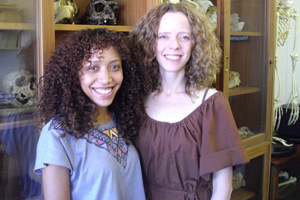Study sheds new light on human origins
17 May 2013 | Story by Newsroom
Understanding the transition between ape-like human ancestors (genus Australopithecus) and ancestors that more closely resemble us (genus Homo) is one of the hottest topics in palaeoanthropology, according to Associate Professor Rebecca Ackermann, from UCT's Department of Archaeology.
Australopithecus sediba is a species described in 2010 whose fossil remains were originally found at a site near Johannesburg by Prof Lee Berger (Wits), and dated to 1.98 million years ago.
It appears, in many respects, to bridge these ape-like and human-like forms, but some scientists have denied that it is a unique species, instead stating that it is just a late-lived member of Australopithecus africanus, the species to which many of South Africa's well-known fossils (such as Mrs Ples and the Taung child) belong.
But a recent study published in the journal Science closely examines the lower jawbone and teeth of Au. Sediba, proving conclusively that it is unique, and different from Au. Africanus.
Lauren Schroeder, a PhD student in the Department of Archaeology at UCT, and Ackermann, her supervisor, were part of the scientific team analysing these fossils using data extracted from laser surface scans of the juvenile and adult mandibles.
Their role in the project was to examine growth within this species, relative to other living and extinct species. They demonstrated that the growth trajectory of Au. Sediba was unlike that of Au. africanus or living chimpanzees and humans, though it does share some features with specimens referred to the species Homo erectus.
This research, combined with additional analyses of mandibular size and shape variation performed by the other team members, supports the unique appearance of Au. Sediba, and upholds it as a possible transitional species between ape-like and human-like ancestors.
 This work is licensed under a Creative Commons Attribution-NoDerivatives 4.0 International License.
This work is licensed under a Creative Commons Attribution-NoDerivatives 4.0 International License.
Please view the republishing articles page for more information.










